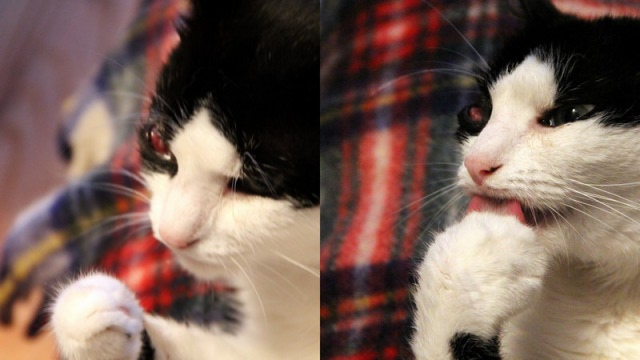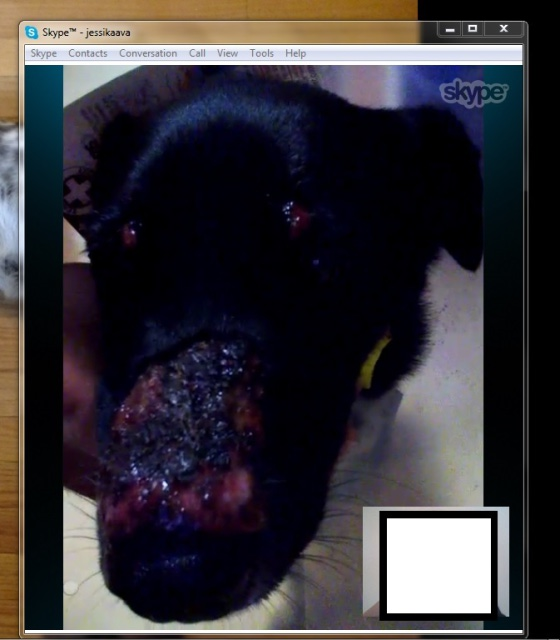QuestionHello, I have a 1 year cat who only uses the litter box for poop (at one time she used it for pee also) but now she is goes on my carpet!!! I have tried almost all of the sprays for cleaning and still she goes on my carpet. She is a in-door cat but I am getting ready to put her out because I have now had my carpets cleaned SEVERAL times. Is there a in-door plant that I can put in that room that cats don't like? What else do you recommend?
Answer What she is doing is called inappropriate elimination as opposed to territorial marking, but sometimes they do both.
Cats usually do this for a number of reasons.
You moved her litter box and she doesn't like where it is, too much traffic, too much noise, etc.
You changed the litter type and she doesn't like the brand you changed too.
There is another cat around the house outside and it is making her nervous so she is marking areas.
She might also have a bladder infection or cystitis. Cats are known for peeing in places to make you mad so you will pay attention to her.
If this continues I would take her in for a check up and discuss the issue with the vet.
Sometimes putting foil on the areas she pees on will deter her, sometimes they just go around it.
I totally understand as I have a 14 yr old that has never wet in the house and now she is peeing on my floor too. She spends all day outside then comes in and pees. I know what her problem is and there isn't much I can do but keep an eye in her and put her out as soon as I see her starting to pee.
Your cat is pretty young so I would examine the points I made above and get her into the vets for a check up on her bladder.
Plants will never deter this problem.
Here are some tips and some more info:
Stress: Stress can be a major cause of inappropriate elimination in cats of all ages. Stressors such as moving, changes in routine, or changes in the makeup of the family can result in inappropriate elimination. Reducing these stressors or decreasing their impact on the household will benefit your cat (and probably you, too!). For instance, when moving, attempt to keep the cat in a quiet portion of the home when packing and during the actual moving day. At the new residence, confine your cat to a quiet room at first (probably a bedroom), placing her food, water, litter box and favorite sleeping material (bed, sweatshirt, etc.) in the room. Spend time with her in that room and feed her and clean the litter box at the usual time. Gradually let her become accustomed to the rest of the house.
Substrate preference: cat in litter boxCats of all ages may develop an aversion to the litter box or substrate (material inside of the litter box). Some of the litters with a 'perfume' or 'antiseptic' smell may dissuade some cats from using them. Trying different types of litter including clumping litter, sand, newspaper, and no litter are things that could be helpful.
Box location: Some cats may not like where a box is located. It may be located too close to their food or water. It may be in a high traffic area where they cannot have privacy. It may be in an area where they can be easily ambushed by another cat. It may be on a different level of the house than where they spend most of their time. In addition to trying various substrates, also place extra boxes around the house to see if box location makes a difference. There should always be at least one more litter box than the number of cats in the household.
Sanitary conditions: Some cats are very particular. Some will not defecate in the same box in which they urinate. Others will not go in a box which has been used by another cat. Just as we do not like to use dirty bathrooms, neither do many cats. If the litter box is not cleaned regularly, they may decide to find a different bathroom.
Possible Solutions to Inappropriate Elimination
*
Have your cat checked by your veterinarian for a possible medical condition, and start treatment for the condition if one exists. If the cat is extremely stressed, talk to your veterinarian about some medications which may help.
*
If you have multiple cats and do not know which one is the culprit, your veterinarian can give you some fluorescent dye to feed one of the cats. The urine from that cat will fluoresce when exposed to a black light.
*
Place numerous litter boxes around the house. You do not have to use anything fancy: dishpans, large plastic containers or other items may work just as well. Try a larger litter box, some behaviorists feel litter boxes are often too small.
*
Use different substrates including newspaper, clumpable and nonclumpable litter, sand, sawdust (not cedar), carpet remnants, and no litter at all. Use unscented litter, since many cats do not like the scented kind. If you find the substrate that your cat prefers is not the one you do, e.g., carpet remnants, try slowly converting the cat back to litter. Place a small amount of litter on the carpet remnants the first week, and if all goes well, use more litter each week until you can finally remove the carpet remnants from the box.
*
Try different depths of litter. Many people put too much litter in the box. Some cats like only a small amount.
*
Clean any soiled areas with an enzyme cleaner designed for use on pet urine and stool. Regular detergents and other cleaners will not break down the urine or feces, and if the cat smells any urine or feces on a carpet or floor, the cat may continue to use that spot to eliminate. In some cases, the carpet or carpet padding may need to be replaced.
*
woman cleaning a litterboxClean the litter boxes at least once daily. Wash the litter box weekly. Do not clean the box with a strong smelling disinfectant, but rinse the box well after washing it.
*
Feed the cat where she is inappropriately eliminating. Many cats will not urinate or defecate in the area in which they are fed.
*
Use upside down carpet runners (the ones with the spikes on the bottom), heavy plastic, aluminum foil, double-sided tape, motion detectors, pet repellents, or scat mats to limit her access to the area where she inappropriately eliminates.
*
Try Feliway, as described above. Be sure to follow the manufacturer's recommendations.
*
Take your cat to the litter box frequently, and if she uses it, praise her, or even give her a treat.
*
If you catch your cat in the act of urinating or defecating outside of the box (or even using the digging motion), use a remote correction. This generally means doing something that will startle her. Tossing a pop can with a few coins inside of it and taped shut toward the cat (but not at her!) may get her to stop. Foghorns, whistles, and water pistols are other options. It is best if she does not associate you with the correction, but thinks it 'comes out of the blue.'
*
Do NOT punish the cat. Punishing the cat, including rubbing her nose in the soiled area will not help, and will probably increase the stress on the cat.
*
In some situations, it may be helpful to confine the cat to a small room with food, water, toys, bed, and litter box. Once she is using the litter box in the smaller area, gradually allow her into larger areas of the house.
I hope this helps some.

 Calf with broken leg
Question
Finally home and taken
Dear Jana
Im hoping th
Calf with broken leg
Question
Finally home and taken
Dear Jana
Im hoping th
 Dog isnt eating.
Question
Jack
I have a 21 month old Chihuahua-terrier/b
Dog isnt eating.
Question
Jack
I have a 21 month old Chihuahua-terrier/b
 Cat Eye Infection/Cancer
Question
Eye Infection
You should know that my 9
Cat Eye Infection/Cancer
Question
Eye Infection
You should know that my 9
 Giant Blisters/Scab on Nose & Spreading
Question
Dogs Snout and Eye
Hello,
We have take
Giant Blisters/Scab on Nose & Spreading
Question
Dogs Snout and Eye
Hello,
We have take
 Guinea Pig Eyes
Question
Bad Eye
Hello, yesterday we purchased a
Guinea Pig Eyes
Question
Bad Eye
Hello, yesterday we purchased a